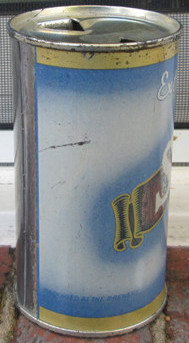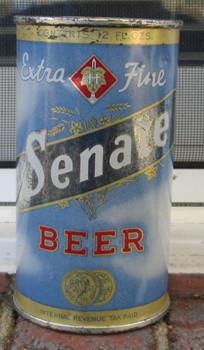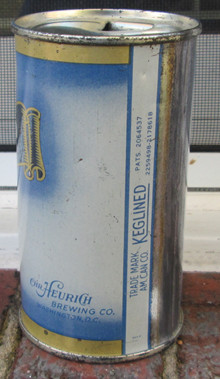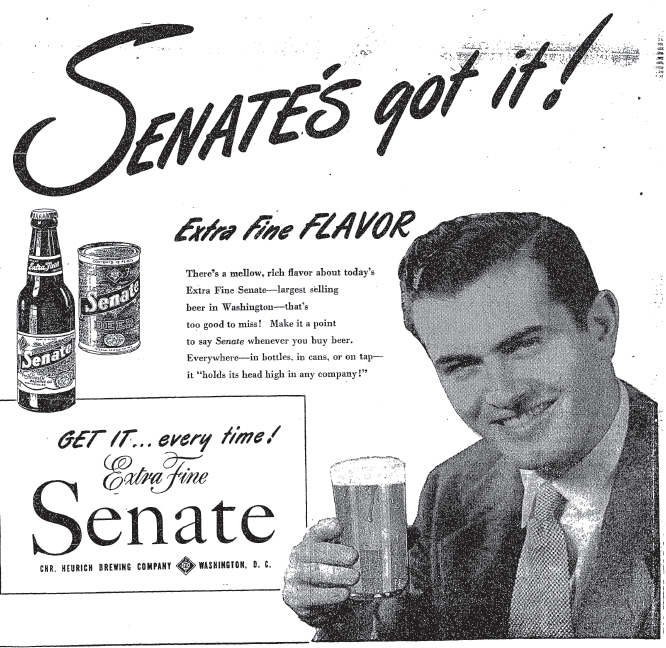Heurich "Extra Fine" 1949
 |
 |
 |
This month I want to highlight another can from DC's Christian Heurich Brewing. As with my Heurich Lager page in August, this is from my upcoming book on Heurich, which will be published in Spring 2017 by McFarland. I covered some of this material in my August 2008 Senate 250 page, but I did a lot of research since then.
Senate Beer remained the brewery’s main product after the war. In February 1947, Heurich advertised that "Cans Were Back" after World War II rationing had ended and the restrictions on canning beer for civilian use were lifted. They canned Senate Beer, Senate Ale, and Senate Bock, although the latter two were apparently only canned briefly as the brewery concentrated on the beer. Unfortunately for the brewery, they began to have problems with bad batches of beer which damaged Senate’s reputation beyond the point it could be salvaged, and the company’s last decade would be spent trying to regain lost market share.
Sales had increased every year from 1933 until 1946. They began to slip in 1947 and then “decreased alarmingly,” a trend that continued into 1950. A new brewmaster, Frank Omlor, replaced the previous brewmaster, who had been fired in August 1947. Omlor immediately found that the brewery had “one of the most serious infections that can happen to a beer.” Something had come into contact with the beer and was giving Senate a “woody” or “musty” taste. They struggled to find where the infection originated. From late 1946 until August 1949 samples the brewery sent to the Wallerstein Laboratories came back reporting that the beer had normal “analytic characteristics,” but that many of the samples had a disagreeable taste. It took fifteen months before they found the contamination that caused the problem was spreading through tanks in Cellar C, one of the five aging cellars in the enormous brewery. From there the infection, which Omlor described as an “odor” spread through other tanks as the beer passed from one to another. The equipment in Cellar C was ripped out and entirely replaced, even down to rubber gaskets and filters. Even the yeast had to be “continuously” replaced because it spread the “bad flavor.” Other tanks were recoated and the cellars were repainted. They never did find the “original source for the cause” of the problem. However, it was not until late 1949 that they began to produce Senate Beer that did not have a musty, woody taste.
The brewery’s advertising reflects their frantic attempts to counter their declining market share even as they struggled to find the source of the spoiled batches. In 1947 April the brewery ads began asking if you "Had a Senate Lately?” which sounded a bit pleading after the confident pre-war “It Holds its Head High in Any Company.” In July 1947 they started a campaign asking customers to compare Senate to other premium beers and to "Make This Test," taste-testing Senate with other beers, including imports. Such advertising themes were common with brands that feared they were losing ground to other brands, and Senate sales were plummeting.
In the Spring of 1948 they added the "Extra Fine" tag to their cans and advertising. This campaign lasted from February to September 1948 when they switched to the white label can.
 |
The details about the Heurich Brewery's struggles come from the records of the Appeals Board of the National Production Authority during the Korean War (1950-1953). Metal was rationed during the Korean War, although not to the degree they were in the Second World War. While brewers could only use cans when producing beer for the military from 1942-1946, during Korea they were allowed a quota based upon previous years' sales. Brewers could appeal to have their quota raised, which the Heurich Brewery did in 1951. They argued that their quota was set too low because it was based on a period of dropping sales of Senate, and on their early 1950 sales of a new brand, Old Georgetown. Their old brand was irrevocably damaged by their "musty" problem, and they had not had enough time to introduce Old Georgetown to customers.
The Appeals Board files contain the lab reports on the problems with Senate Beer, as well as letters from local beer dealers on the brand's dropping sales. The letters back the brewery's contention that Senate was too badly damaged to remain the brewery's main brand. One dealer even noted that customers got angry when he suggested they try Senate.
Why was the disagreeable taste not discovered before the beer had reached the consumer, not once but multiple times over several years? The elder Christian Heurich (1842-1945) drank his own beer regularly. A trained brewer with over seventy years’ experience, he would have likely detected the problem immediately. His son, Chris, however, was not a trained brewer. His degree was in business. Moreover, he liked to drink hard liquor, not beer. There is even less excuse for the brewmaster to have failed to notice the problem. Brewery management’s failure to notice the problem quickly enough out of what seems to have been simple carelessness, something exceptionally difficult to imagine happening under Christian Heurich Senior’s management.
For more on Heurich see these pages...
Christian Heurich
Heurich's Radio Ads
For more on the brewery's post Second World War problems, please see these pages...
Heurich Lager Can (1955)
Old Georgetown
Senate 250
Senate Ale
You can see the short bio of Heurich I wrote in 2011 for the German Historical Institute at their site. (opens new window)
And my book on Heurich, which will be coming out in Spring 2017, published by McFarland (opens new window).
“Display Ad,” The Washington Post, February 24, 1947, 10.
This is based upon the dating codes on cans made for all three brands. The Ale and Bock cans only have codes for 1947 and are exceptionally scarce. They could have been sold in 1948 (the date code only indicates where the can was made, not when it was filled), and it’s possible that the brewery ordered a large batch of the cans and filled a portion when necessary.
“Hearing before the Appeals Board of the National Production Authority (October 11, 1951), NARA-CP, RG 277. UD, Entry30-NPA Appeals Dkt, Box 23, 15-18. The same folder contains multiple reports from the Wallerstein Laboratories on their tests of Senate Beer dating from December 20, 1946 through August 23, 1950.
“Display Ad,” The Washington Post, April 24, 1947, 2.; “Display Ad,” The Washington Post, July 10, 1947, 15.; “Display Ad,” The Washington Post , August 7, 1947, 6.
For details on Chris Heurich I used letters from Carl Keyser to family members, November 1 0, 1 981, 16.; December 1, 1981, 31.; December 29, 1981, 60. Copy in author’s possession.
